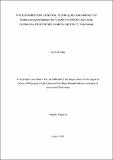| dc.description.abstract | In Tanzania, the invasive plant Parthenium hysterophorus threatens natural and semi–natural
environments. Little is known about how this species affects plant–pollinator interactions and
soil–chemical properties. Roadside survey was conducted to assess P. hysterophorus invasion
status within and outside Arusha National Park (ANP), Tanzania. Soil samples were also
collected in invaded and uninvaded plots to investigate the impact of P. hysterophorus on
soil–chemical properties. To test alternative natural–based management strategies, the study
examined the bio–herbicide potential of Desmodium uncinatum leaf (DuL) crude extract and
the competitive ability of fodder legume plant species (Lablab purpureus, Desmodium
intortum and Medicago sativa) to suppress P. hysterophorus in pot and plot experiments.
Results showed that ANP is currently uninvaded with P. hysterophorus, but some adjacent
villages i.e. King’ori, Maleu, Napoco, Ngongongare, Ngurdoto, Oligilai and Sakila have
already invaded by this invasive. Parthenium hysterophorus invaded site was more acidic
with lower electrical conductivity, less calcium and phosphorus, and high cation exchange
capacity. The DuL extract suppressed P. hysterophorus growth vigour, particularly at higher
concentrations (>70%). At these concentrations, the invasive seedling stem height was >30%
shorter, and seed germination was inhibited by >55% compared to seedlings sprayed with
lower concentrations. When P. hysterophorus was grown in combination with all three test
plants, its seedling stem heights and total fresh biomass were reduced by >60% and >59% in
pots, and >40% and >45% in field plots respectively, compared to when grown alone or in
mixture with just D. intortum or M. sativa.
Moreover, surveys conducted on invaded and uninvaded sites to investigate the impact of P.
hysterophorus on plant–pollinator interactions when two common target plants (Ocimum
gratissimum and Ageratum conyzoides) were present showed that flower visitation rate to
target plants was significantly lower in invaded plots than in uninvaded plots. This implies
that P. hysterophorus may be disrupting pollen flow. The study recommends that the use of
bio–herbicide and suppressive plant species to control the invasive should be promoted.
However, it emphasizes the use of native suppressive plant species because non–natives may
turn into invasives in the future. | en_US |


